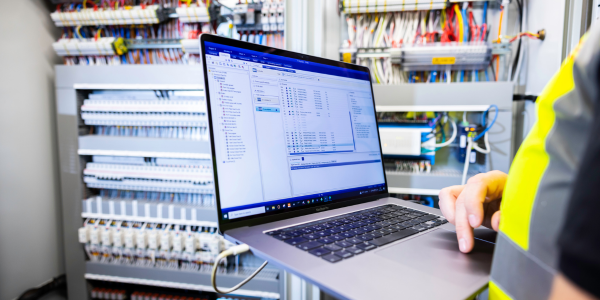If you’re seeking essential insights into what an Integrated Building Management System (IBMS) is, then look no further. Leveraging our expertise in controls technology, we’ve curated a comprehensive guide on integrated building management systems, delving deep into their complexities, unique features, as well as their pros and cons. Explore this resource to fully grasp the potential of integrated systems for optimising your building or facility.
What is an integrated building management system?
A Building Management System (BMS) uses sensors and devices to monitor and regulate individual systems, such as Heating, Ventilation and Air Conditioning (HVAC), lighting, security access and more (see our complete guide to building automation control systems here).
An Integrated Building Management System (IBMS), on the other hand, integrates various standalone systems within a building into a single comprehensive platform. This includes not only the building systems mentioned above but also other systems, such as energy management, water management, lifts etc. While a traditional BMS has limited integration capabilities, an IBMS enables seamless communication and coordination among different building systems. It allows for data sharing, centralised control and automation across multiple systems, leading to improved efficiency and performance. An IBMS also goes one step further by providing advanced functionalities beyond basic control, including data analytics, predictive maintenance, optimisation of resource usage and intelligent decision-making based on data from multiple systems.
In short, an IBMS offers a more comprehensive and integrated approach, allowing for greater control, efficiency and optimisation of building resources. It is the sole point of control for an entire building.
Key advantages of integrated building management systems
Integrated building management systems offer numerous benefits, ranging from improved efficiency and cost savings to enhanced comfort, safety and sustainability, making it an essential tool for modern building management.
Enhanced efficiency: An IBMS can streamline operations by centralising control, optimising resource usage and automating processes, resulting in improved efficiency and reduced energy consumption.
Comprehensive monitoring: An IBMS provides more comprehensive real-time monitoring of various building systems, allowing for quick identification of issues and proactive maintenance, leading to increased reliability and operation time.
Cost savings: Through efficient resource management, predictive maintenance, and optimised functioning, integrated building management systems help reduce operational costs and extend the lifespan of building equipment, resulting in longer term savings.
Improved occupant comfort and safety: An IBMS enables greater and more precise control over environmental conditions such as temperature, lighting, and air quality, enhancing occupant comfort and well-being. Additionally, integrated security and safety features contribute to a safer building environment.
Flexibility and scalability: Integrated building management system platforms are highly adaptable and can accommodate changes in building layouts, systems and functionalities, making them suitable for a wide range of building types and sizes. They can also integrate with new technologies and expand as the building’s needs evolve.
Data-driven insights: An IBMS collects and analyses data from various building systems, providing valuable insights into performance, usage patterns and trends. These insights enable informed decision-making, optimisation strategies and continuous improvement of building operations.
Regulatory compliance: An integrated system facilitates compliance with building codes, energy efficiency standards and environmental regulations through automated reporting, monitoring and control functionalities.
Is an integrated building management system right for your building or facility?
In recent years, there has been a significant drive, by both the UK government and various building authorities, to enhance the energy efficiency of non-residential buildings, aligning with broader initiatives to transition toward a Net-Zero Strategy.
This momentum has been bolstered by the introduction of stringent standards and incentivisation measures, including the following:
- L2 Building Regulations, designed to reduce energy consumption, improve energy efficiency and lower carbon emissions in non residential structures.
- Energy Performance Certificates, required for most buildings in the UK to provide information on the energy efficiency of a building and recommendations for improving its performance.
- Green building certification schemes, such as BREEAM (Building Research Establishment Environmental Assessment Method), encourage the implementation of energy-efficient building management practices, including the use of various building management systems.
- Industry standards and guidelines: Professional bodies and organisations in the UK have developed standards, requirements and best practices for energy-efficient building management.
Installing and effectively maintaining an integrated building management system can be part of the answer to the drive for greater energy efficiency in non-residential buildings. Implementing an IBMS is not the only solution, but it can play a crucial role in achieving energy efficiency goals in buildings as part of a comprehensive approach that also includes standards, incentives and other energy-saving measures.
Overall, while not every building may be suitable for an IBMS installation, these are few in number. The majority of buildings can benefit from the enhanced control, efficiency, and performance that integrated building management systems have to offer.
It’s essential for building owners to assess their specific needs, constraints and objectives before deciding whether to invest in an IBMS. Moreover, installing and maintaining an IBMS requires a dedicated specialist, who can ensure the work is carried out correctly and safely. Consulting experienced building automation experts or an IBMS provider, can help determine the feasibility and potential benefits of installing an integrated system in a particular building.
Get in touch
Cube Controls is an established and experienced supplier of Building Management Systems, specialising in the design and set-up of bespoke environmental and energy control programmes for commercial buildings and property.
To find out how Cube Controls can support you at all stages of design and consultancy, installation and modification and maintenance of your building management systems, contact our expert and friendly team on 01903 694279 or sales@cubecontrols.co.uk.




